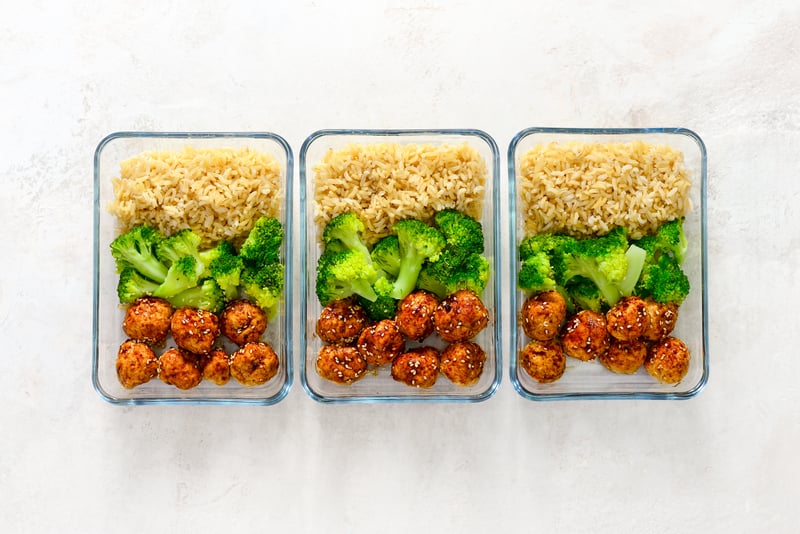Fixation Meals: Can They Help You Stay on Track and Reach Your Goals?

Tis the time of year when people are adjusting their diets to hopefully reverse any holiday weight gain and refocus on health goals. That could include eating more protein, adding vegetables or fiber to every meal, cutting back on calories or carbs, or improving key health metrics. While variety is the spice of life, many people find that fixation meals can help them better stay on track, especially as they transform their eating patterns.
What Are Fixation Meals?
Fixation meals typically refer to meals that are repeated regularly over a period of time. Fixation meals can come from foods people simply love and just can’t seem to get enough of. (Such as when you order the same meal from a favorite restaurant every time you go.) But they can also be carefully planned meals that meet your specific nutrition goals.
We all know folks who seem to have the same breakfast every morning—year-round. Some common breakfast fixation meals can include:
- A veggie-filled omelet with a sprinkle of cheese
- Greek yogurt with nuts and berries
- Rolled or steel-cut oats with fresh fruit and nuts (and perhaps a scoop of protein powder)
- Whole grain toast with avocado
- Overnight oats with chia seeds
- Protein smoothies
Lunch may also be regularly repeated until it becomes a fixation meal (until you tire of it and choose something else). Common options include:
- Chicken or tuna salad
- Grain bowls
- Lentil or tomato soup
- Whole grain wraps or sammies
Even your afternoon snack may become a fixation as you look for a post-lunch pick-me-up. Some healthy options include:
- Greek yogurt with fresh fruit and a handful of almonds
- Fruit slices with either nut butter or a cottage cheese or yogurt dip
- Hummus with vegetable slices
- A slice of cheese
- A hardboiled egg
Especially if you are busy during the week and following a structured meal plan, dinner is also a common time to choose fixation meals. Common options include:
- Protein and veg combinations like grilled salmon or baked chicken with a side of steamed or roasted vegetables with a drizzle of olive oil.
- Stir-fries, which are quick to make and can be loaded with vegetables and quality protein sources from beef to shrimp to tofu and often served over quinoa or rice.
- One-pot meals like chili, stews, soups, or casseroles.
- Especially in summer months, a hearty salad topped with protein becomes a go-to meal.
- Spaghetti and other pasta dishes are also common as they can be tossed together quickly and tend to be family favorites.
Pros of Fixation Meals
Fixation meals come with some pretty appealing benefits. For instance, they can help you stay on track to reach your goals, especially if you’re working hard to meet specific dietary goals (e.g., hitting macros or calorie counts). If you are increasing your grams of protein, eating specific high-protein meals can help you achieve your targets more consistently.
If you are trying to gain muscle or lose fat, again, fixation meals can be tailored to help you reach your calorie goals while ensuring you are hitting your macros (such as consuming fewer calories and more protein).
Fixation meals can also make meal planning and prep much easier, saving you hours throughout the week. You know exactly what you need, so you can get in and get out of the grocery store and prep for multiple meals once or twice each week. For instance, if you know you often eat stir-fries, you can make one large batch of quinoa or rice to reheat for dinner. Again, this also makes it easier to ensure you’re hitting your nutritional goals.
The right fixation meals can also help the entire family eat more healthfully as you repeat meals that you know everyone in the family loves.

Cons of Fixation Meals
Along with the good, there are also downsides to fixation meals. One big downside is the lack of variety. If you’re eating the same foods for breakfast, lunch, and dinner, you can easily become bored. This can decrease motivation and make it tempting to reach for something (anything) else.
Another drawback is that the lack of variety can lead to missing out on certain nutrients. Especially if you choose the same protein sources (whether chicken, tofu, tuna, or beans) and the same vegetable (whether spinach or other leafy greens, broccoli, cauliflower, or sweet potatoes), you’re still missing out on a rainbow of nutrients that are necessary for a healthy diet. This is true even if you’re eating healthy “superfoods.”
Another drawback to be aware of is developing an unhealthy relationship with food. For some folks, food fixations can lead to rigid dietary “rules” and lead to anxiety around eating. This type of anxiety could contribute to disordered eating patterns, such as orthorexia, if the meals strictly control food intake.
Creating a Balance with Fixation Meals
Fixation meals can be used to stick to a healthy diet and reach your goals. But as with so many things, it’s all about balance. For instance, creating meal themes rather than repeating the same recipes night after night can help you plan and prep but still provide plenty of variety. In turn, you’ll ensure a wider range of nutrients.
Common themes include:
- Days of the week, such as meatless Mondays with vegetarian options, taco Tuesdays (there are so many ways to make tacos!), world cuisine Wednesday for some international flare, throwback Thursdays to enjoy comfort foods, fish Fridays for any type of seafood, slow cooker Saturdays so you can focus on family and enjoy a comforting meal together at the end of the day, and soup and salad Sundays as you prepare for the next week.
- Nutritional themes focus on your goals for each day or meal. This can be super helpful if you’re cycling through your meal plan and including high-protein or low-carb days with moderate-carb days, for instance.
- Cultural or regional themes are a great way to explore different types of cuisine and enjoy a wide range of flavors and ingredients.
- Seasonal themes are a wonderful way to ensure you’re eating fresh foods that are cost-effective and environmentally friendly. You’ll start with the produce that’s in season and choose your recipes from there.
- Family favorites allow everyone to pick a specific meal or theme. This helps engage the entire family in meal planning and preparation.
You can also rotate through favorite recipes, adding an occasional new recipe that fits into your plan to see if it’s good enough to make it into the rotation as you tire of an older one or move into a new season.
It’s also important to be welcome to some flexibility. Occasionally deviating from your meal plan allows you to enjoy social events and satisfy cravings, and it promotes a healthy relationship with food. Remember, fixation meals can be useful tools, but they also should be approached with a balanced mindset that promotes nutritional needs and mental well-being. This type of balanced approach can ensure a sustainable, enjoyable diet that helps you reach your goals.






